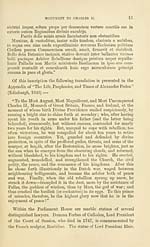Grampian Club > Monuments and monumental inscriptions in Scotland > Volume 1
(36) Page 12
Download files
Complete book:
Individual page:
Thumbnail gallery: Grid view | List view

12 EDINBURGHSHIRE.
aud private soldiers of the 78tli Highland Eegiraent, who fell in
the suppression of the mutiny of the native army of India in the
years 1857 and 1858. This memorial is erected as a tribute of
respect by their surviving brother officers and comrades, and by
many ofi&cers who formerly belonged to the regiment, a.d. 1861."
In Parliament Close, occupying the narrow space between St.
Giles' Church and the Parliament House, stands the equestrian
statue of Charles II. During the rejoicings which in the city
attended the event of the Eestoration, the Corporation resolved to
rear a statue in honour of the restored king, and an artist at
Eotterdam was commissioned to execute the work. The statue
was reared in 1685, when the artist was recompensed with a
payment of £2,580 Scots, or £215 sterling.* The site selected is
not very creditable to the taste of Edinburgh citizens, for while the
statue is dwarfed by the high buildings which surround it, it
occupies the spot where were entombed the remains of John
Knox, the illustrious reformer.-f- After the conflagration of 1700,
which destroyed the range of buildings in Parliament Close, the
statue was temporarily deposited in the Calton jail ; it was after-
wards placed on a new and handsome pedestal, in which were
inserted two marble tablets. These tablets present the following
inscription : —
" Augustisimo magnificentissimo
Carolo Secundo,
Britanniarum Galliarum & Hibernie
Monarchae
Invictissimo
Cujus Natalitijs providentia arrisit Divina Asterisca JNIeridiano
eodem momenti conspicua qui postquam adolescentiam in acie sub
patre, exegisset illo demum, obtruncate, jus finim, per biennium
slrenue quidem sed improspere vendicavit Rebellioni namq; ssepius
* Maitland's "History of Edinburgh," Edinb., 1753, fol. p. 105.
t A square stone inscribed with ihe initials "J. K., 1572," a few feet to the west
of the statue, denotes the spot where it is supposed the reformer was buried, but Dr.
Daniel Wilson is inclined to believe that the monument stands directly over the
Reformer's grave. The locality formerly constituted a portion of the churchyard of
St. Giles. See Dr. Daniel Wilson's "Memorials of Edinburgh," vol. i., p. 84.
aud private soldiers of the 78tli Highland Eegiraent, who fell in
the suppression of the mutiny of the native army of India in the
years 1857 and 1858. This memorial is erected as a tribute of
respect by their surviving brother officers and comrades, and by
many ofi&cers who formerly belonged to the regiment, a.d. 1861."
In Parliament Close, occupying the narrow space between St.
Giles' Church and the Parliament House, stands the equestrian
statue of Charles II. During the rejoicings which in the city
attended the event of the Eestoration, the Corporation resolved to
rear a statue in honour of the restored king, and an artist at
Eotterdam was commissioned to execute the work. The statue
was reared in 1685, when the artist was recompensed with a
payment of £2,580 Scots, or £215 sterling.* The site selected is
not very creditable to the taste of Edinburgh citizens, for while the
statue is dwarfed by the high buildings which surround it, it
occupies the spot where were entombed the remains of John
Knox, the illustrious reformer.-f- After the conflagration of 1700,
which destroyed the range of buildings in Parliament Close, the
statue was temporarily deposited in the Calton jail ; it was after-
wards placed on a new and handsome pedestal, in which were
inserted two marble tablets. These tablets present the following
inscription : —
" Augustisimo magnificentissimo
Carolo Secundo,
Britanniarum Galliarum & Hibernie
Monarchae
Invictissimo
Cujus Natalitijs providentia arrisit Divina Asterisca JNIeridiano
eodem momenti conspicua qui postquam adolescentiam in acie sub
patre, exegisset illo demum, obtruncate, jus finim, per biennium
slrenue quidem sed improspere vendicavit Rebellioni namq; ssepius
* Maitland's "History of Edinburgh," Edinb., 1753, fol. p. 105.
t A square stone inscribed with ihe initials "J. K., 1572," a few feet to the west
of the statue, denotes the spot where it is supposed the reformer was buried, but Dr.
Daniel Wilson is inclined to believe that the monument stands directly over the
Reformer's grave. The locality formerly constituted a portion of the churchyard of
St. Giles. See Dr. Daniel Wilson's "Memorials of Edinburgh," vol. i., p. 84.
Set display mode to: Large image | Transcription
Images and transcriptions on this page, including medium image downloads, may be used under the Creative Commons Attribution 4.0 International Licence unless otherwise stated. ![]()
| Publications by Scottish clubs > Grampian Club > Monuments and monumental inscriptions in Scotland > Volume 1 > (36) Page 12 |
|---|
| Permanent URL | https://digital.nls.uk/80690861 |
|---|
| Description | Vol. I. |
|---|---|
| Attribution and copyright: |
|
| Description | Note: Numbers 24-41 are relative to but not part of the Club's series. |
|---|---|

